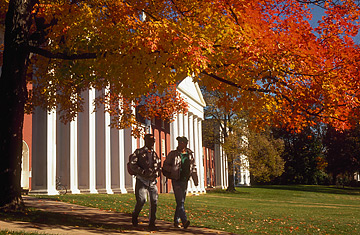
Washington and Lee University, Lexington, Virginia
But around the same time, the state of Kentucky ordered the university to improve its academic credentials, and a decade later that improvement has come at a high price, literally. Sure, hundreds of millions of dollars in research money have poured in and Louisville now welcomes an incoming student class with much higher test scores, but those fortunate enough to be accepted must pay a much steeper tuition; in just the last three years, the annual in-state undergraduate tuition has grown 40%, to $6,252 this academic year. "We have had to raise tuition each of the last four or five years," says University of Louisville president James Ramsey. "And in most of those years, there has been a double-digit increase. That is not something that we have enjoyed doing."
But later today the school's trustees are expected to do something about it. Following the example of the University of North Carolina-Chapel Hill, Louisville is joining more than two dozen other schools that have begun promising a free education — books, tuition, and room and board — to students from poor families. Students accepted at Louisville who meet income guidelines will be guaranteed that if federal aid won't cover their costs — all of them — the universities will make up the difference. Schools like Miami of Ohio and UNC-Asheville have adopted similar programs.
Officials at Louisville and North Carolina say universities are trying to get the message out that poor students can still afford college even as tuition is increasing and federal aid is shrinking. "It's like buying a car. There is a big difference between the sticker price and what you actually pay," Ramsey said. "We think there is a lot of aid that these students already qualify for, but they are being scared away from even applying. By guaranteeing they can go to school for free, we're hoping more of them will take the time to apply."
UNC-Chapel Hill began the program in 2003, at first offering the no-loans promise to any student from families earning less than 150% of the federal poverty threshold. Since then it has expanded the income cutoff to 200% of the poverty line, and the school currently has about 900 students attending cost-free. "All of us in higher education have been concerned about access and affordability," said Shirley Ort, director of scholarships and student aid at Chapel Hill. "But we did this frankly to simplify our message. With all the media focus about spiraling college costs, we were afraid too many students were being scared away."
Since UNC began offering its no-loans guarantee, about 25 other schools have offered similar programs. Ort said UNC took its lead from Princeton, which in 1998 began phasing in its current no-loans policy for all recipients of federal financial aid.
The problem of rising tuitions hardly surprises Jennifer Pae, the president of the United States Student Association. The 2005 graduate of the University of California at San Diego said students feel pinched from every direction. Federal grants are down, student loan interest rates are up, and tuition continues to rise. "We're seeing students across the U.S. locked out of an education," she said. "Federal aid, especially, has decreased. Students are having to work two and even three jobs to make it"
That's why today she plans to be in Washington for "College Affordability Day," Pae said. She'll lead a group of students and higher-education lobbyists at a meeting on Capitol Hill with a handful of newly empowered congressional Democrats. "We're hoping for some changes."
The College Board's 2006 report on affordability says tuition increases are slowing, but are still up 35% from five years ago at four-year public universities. It's a trend felt even in Kentucky, where incomes and tuitions are lower than the national average.
The higher rates have made it harder to sell college to some students, especially those from low-income families, said Robert Jones, a guidance counselor at Louisville's Central High School. "Every year, we have seniors that are always worried about how they can afford a college education," said Jones, who welcomed the changes at U of L. "It is becoming more and more expensive. ... There are a lot of students who feel they just can't afford it, and they are opting to go to two-year college first."
That's too bad, said Ramsey, a former state budget director, who says Kentucky badly needs more college graduates. "Our per capita personal income is only about 82% of the national average, and that's largely because we have an undereducated population," Ramsey said. "We see this as doing our part in developing a more educated workforce, with more college degrees."
